Related Research Articles
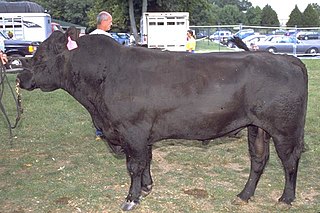
The Aberdeen Angus, sometimes simply Angus, is a Scottish breed of small beef cattle. It derives from cattle native to the counties of Aberdeen, Banff, Kincardine and Forfar in north-eastern Scotland. In 2018 the breed accounted for over 17% of the UK beef industry.

Holstein Friesians are a breed of dairy cattle that originated in the Dutch provinces of North Holland and Friesland, and Schleswig-Holstein in Northern Germany. They are known as the world's highest-producing dairy animals.

The Longhorn or British Longhorn is a British breed of beef cattle characterised by long curving horns. It originated in northern England, in the counties of Lancashire, Westmorland and Yorkshire, and later spread to the English Midlands and to Ireland. It was originally a slow heavy draught animal; cows gave a little milk, although high in fat. In the eighteenth century Robert Bakewell applied his methods of selective breeding to these cattle, which for a short time became the predominant British breed. Both the numbers and the quality of the breed declined throughout the nineteenth century and for much of the twentieth. A breed society was formed in 1878, and a herd-book published in that year.

The Dutch Belted breed of dairy cattle is, according to records, the only belted breed of cattle tracing back directly to the original belted or "canvassed" cattle which were described in Switzerland and Austria. These Gurtenvieh were evidently moved by Dutch nobility from the mountain farms of canton Appenzell and County of Tyrol during or soon after the feudal period. The Dutch were very protective of their belted cattle and would generally not part with them. The cattle were highly prized for their milking and fattening abilities. The breed began to flourish in the Netherlands around 1750. Now, the cow is too rare to become a popular type of beef.

The Simmental or Swiss Fleckvieh is a Swiss breed of dual-purpose cattle. It is named after the Simmental – the valley of the Simme river – in the Bernese Oberland, in the canton of Bern in Switzerland. It is reddish in colour with white markings, and is raised for both milk and meat.

The Dairy Shorthorn is a British breed of dairy cattle. It derives from the Shorthorn cattle of Teesside, in the North Riding of Yorkshire and in Northumbria in north-eastern England. The Shorthorn was for this reason at first known as the Durham or Teeswater.
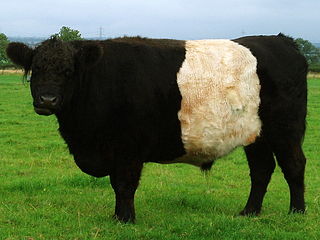
The Belted Galloway is a traditional Scottish breed of beef cattle. It derives from the Galloway cattle of the Galloway region of south-western Scotland, and was established as a separate breed in 1921. It is adapted to living on the poor upland pastures and windswept moorlands of the region. The exact origin of the breed is unclear, although the white belt for which they are named, and which distinguishes the breed from black Galloway cattle, is often surmised to be the result of cross-breeding with the similarly-coloured Dutch Lakenvelder breed.

South Devon cattle are a British breed of large beef cattle. It originated in the counties of Devon and Cornwall in south-west England, and is mentioned from the 18th century. It was a dual-purpose breed, kept both for its milk and for beef. Since 1972, selection has been for beef only.

The Shorthorn breed of cattle originated in the North East of England in the late eighteenth century. The breed was developed as dual-purpose, suitable for both dairy and beef production; however, certain blood lines within the breed always emphasised one quality or the other. Over time, these different lines diverged, and by the second half of the twentieth century, two separate breeds had developed – the Beef Shorthorn, and the Milking Shorthorn. All Shorthorn cattle are coloured red, white, or roan, although roan cattle are preferred by some, and completely white animals are not common. However, one type of Shorthorn has been bred to be consistently white – the Whitebred Shorthorn, which was developed to cross with black Galloway cattle to produce a popular blue roan crossbreed, the Blue Grey.
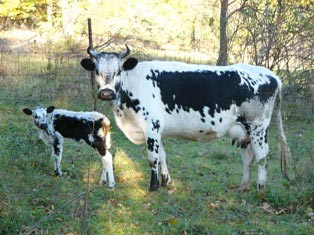
The Randall Lineback or Randall is an American breed of cattle. It originated in Sunderland, Vermont, and is critically endangered.
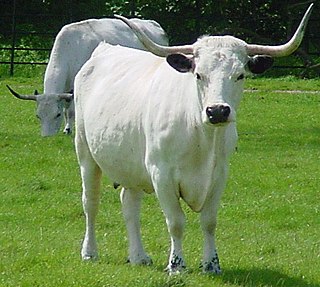
The White Park is a rare breed of ancient horned cattle primarily residing in Great Britain. Two similar semi-feral populations, the Chillingham Wild Cattle in Northumbria and the Vaynol cattle from Gwynedd in North Wales, have a separate breed status. There are relatively small numbers of the White Park cattle in the United States, where they are commonly known as the Ancient White Park in order to distinguish them from the American White Park, which is a population of the British White breed.

The Old Gloucester or Gloucester is a traditional British breed of cattle originating in Gloucestershire and surrounding areas in the West Country of England. It was originally a triple-purpose breed, reared for milk, for beef and for draught use; it is now a dual-purpose animal. It is an endangered breed, and its conservation status is listed as "priority" by the Rare Breeds Survival Trust.
The Agerolese is a breed of dairy cattle from the area of Agerola, in Campania in southern Italy. It is particularly associated with the Sorrento Peninsula and Monti Lattari. It derives from cross-breeding of indigenous Podolica cattle with Italian Holstein-Friesian, Bruna Italiana and Jersey cattle. It is one of the sixteen minor Italian cattle breeds of limited diffusion recognised and protected by the Ministero delle Politiche Agricole Alimentari e Forestali, the Italian ministry of agriculture.

The Japanese Brown is a breed of small Japanese beef cattle. It is one of six native Japanese cattle breeds, and one of the four Japanese breeds known as wagyū, the others being the Japanese Black, the Japanese Polled and the Japanese Shorthorn. All wagyū cattle derive from cross-breeding in the early twentieth century of native Japanese cattle with imported stock, mostly from Europe. In the case of the Japanese Brown, the principal foreign influence was from the Korean Hanwoo and Swiss Simmental breeds.
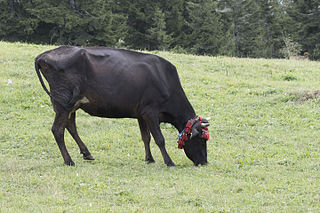
The Anatolian Black, also known as Native Black Cattle, is a breed of cattle that originated in Anatolia, in what is now Turkey. They are used in dairy production, meat production, and as draught animals on small farms. They are primarily raised in central Turkey.
Jutland cattle are a rare Danish breed of cattle used in both dairy and beef production. Bred from the indigenous cattle of Jutland the breed could be light grey, dark grey or black pied with upward curving horns. The first herdbook published in 1881 had a small dairy type and a larger beef type. The dairy cows were small, averaging 120 cm high and weighing 350 kg, producing between 800 and 1000 kg of milk per lactation.
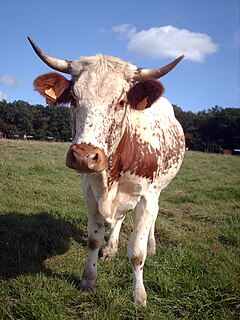
The Ferrandaise is an endangered French breed of domestic cattle from the département of Puy-de-Dôme, in the Massif Central mountains of Auvergne, in central France. It is named for the city and commune of Clermont-Ferrand, the capital of Puy-de-Dôme.

The Podolica is a breed of domestic cattle from southern Italy. It belongs to the Podolic group of grey cattle. It is raised in the regions of Abruzzo, Basilicata, Calabria, Campania, Molise and Puglia. It was formerly distributed throughout most of mainland Italy and as far as Istria, now part of Croatia, and where it is now regarded as a separate breed, the Istrian or Boškarin. The Podolica was in the past bred principally as a draught animal; with the mechanisation of agriculture following the Second World War demand for draught oxen disappeared, and the Podolica is now raised for meat and, to a lesser extent, for milk.
The Blue Albion was a British breed of cattle with an unusual blue roan coat. It originated in the English Midlands in the late nineteenth or early twentieth century, and was a dual-purpose breed, reared both for beef and for milk. It became extinct following the foot-and-mouth outbreak of 1967.

The Japanese Shorthorn is a breed of small Japanese beef cattle. It is one of six native Japanese cattle breeds, and one of the four Japanese breeds known as wagyū, the others being the Japanese Black, the Japanese Brown and the Japanese Polled. All wagyū cattle derive from cross-breeding in the early twentieth century of native Japanese cattle with imported stock, mostly from Europe. In the case of the Japanese Shorthorn, the principal foreign influence was from the Shorthorn, with some contribution from the Ayrshire and Devon breeds.
References
- 1 2 3 Mac an tSíthigh, Seán (8 January 2020). "Droimeann cow granted Native Rare Irish Breed status". RTÉ News . Retrieved 8 January 2020.
- 1 2 3 Glenn Murphy (9 January 2020). "Droimeann cow recognised as native rare Irish breed". Irish Times .
- 1 2 "Herdbook Rules: Droimeann Cattle, a Native Rare Irish Cattle Breed". The Droimeann Cattle Society. Retrieved 9 March 2020.